<< Previous | Displaying results 4676-4700 of 6769 for "" | Next >>
Portrait of Hilde and Gerrit Verdoner, with four bridesmaids, on their wedding day. The bridesmaids are: Jetty Fontijn (far left), Letty Stibbe (second from right), Miepje Slulizer (right), and Fanny Schoenfeld (standing, back). Amsterdam, the Netherlands, December 12, 1933.
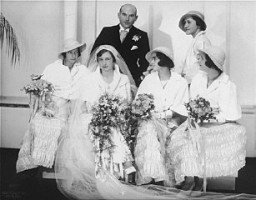
Ruth Kohn (top row, second from left) and her classmates at a school in Prague. Prague, Czechoslovakia, 1928.
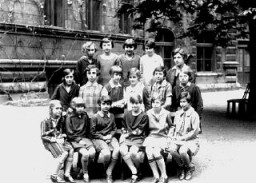
Scene of prewar economic life: Jewish vendors sell their wares at an outdoor market in front of the Stara synagogue. Krakow, Poland, 1936.
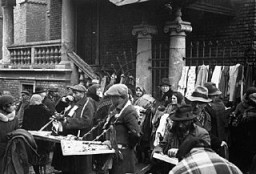
Berta Rosenheim poses with a large cone, traditionally filled with sweets and stationery, on her first day of school. Leipzig, Germany, April 1929.
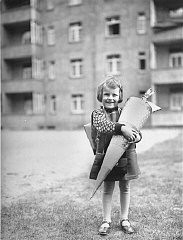
An antisemitic cartoon published in Dr. Kurt Plischke's Der Jude als Rassenschaender: Eine Anklage gegen Juda und eine Mahnung an die deutschen Frauen und Maedchen (The Jew as Race Defiler: An Accusation against Judah and a Warning to German Women and Girls). Germany, ca. 1935.
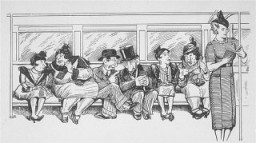
Three Jewish businessmen are forced to march down a crowded Leipzig street while carrying signs reading: "Don't buy from Jews. Shop in German businesses!" Leipzig, Germany, 1935.
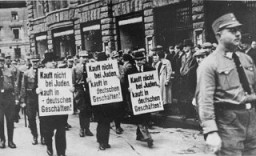
Scene during the boycott of Jewish businesses. A sign on truck carrying Storm Troopers (SA) urges "Germans! Defend yourselves. Don't buy from Jews." Berlin, Germany, April 1, 1933.
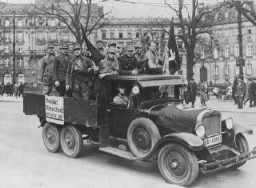
Spectators in the stands of the Zeppelinfeld look on as Adolf Hitler's car moves towards the speakers' platform at the opening of Reichsparteitag (Reich Party Day) ceremonies in Nuremberg. The Zeppelinfeld was part of the Nazi Party rally grounds. Nuremberg, Germany, September 1935.
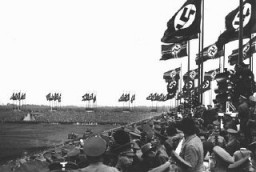
A postcard of the SS St. Louis. May 1939. The plight of German-Jewish refugees, persecuted at home and unwanted abroad, is illustrated by the May 13, 1939, voyage of the SS St. Louis.

Refugees aboard the St. Louis wait to hear whether Cuba will grant them entry. Off the coast of Havana, Cuba, June 3, 1939.

German women at work in the offices of the German Census Bureau. The board gives directions for tabulation: the center column instructs that number 3 is the indicator to be used for Jews. Germany, 1933.
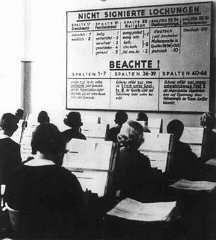
View of a barbed-wire fence separating part of the ghetto in Krakow from the rest of the city. Krakow, Poland, date uncertain. During the Holocaust, the creation of ghettos was a key step in the Nazi process of brutally separating, persecuting, and ultimately destroying Europe's Jews. Ghettos were often enclosed districts that isolated Jews from the non-Jewish population and from other Jewish communities.
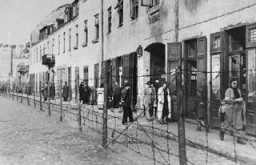
Deportation from the Krakow ghetto at the time of the ghetto's liquidation. Krakow, Poland, March 1943.
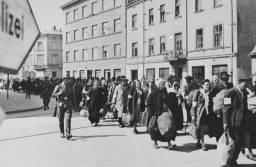
Jews forced to move into the Lodz ghetto. Lodz, Poland, date uncertain. During the Holocaust, the creation of ghettos was a key step in the Nazi process of brutally separating, persecuting, and ultimately destroying Europe's Jews. Ghettos were often enclosed districts that isolated Jews from the non-Jewish population and from other Jewish communities.
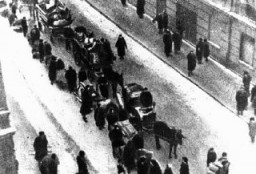
Forced laborers work on the construction of a wall around the Warsaw ghetto area. The Germans announced the construction of a ghetto in October 1940 and closed the ghetto off from the rest of Warsaw in mid-November 1940.
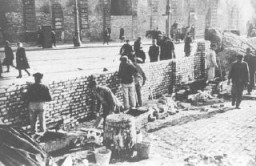
Footbridge over Chlodna Street, connecting two parts of the Warsaw ghetto. The street below was not part of the ghetto. Warsaw, Poland, date uncertain.
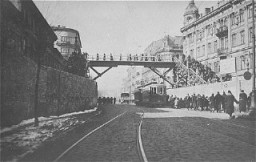
The footbridge over Zgierska Street that joined the two parts of the Lodz ghetto. The street itself was not part of the ghetto. Lodz, Poland, ca. 1941.
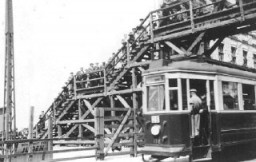
A Jewish man and child at forced labor in a factory in the Lodz ghetto. Lodz, Poland, date uncertain.
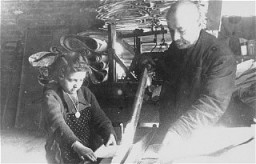
A child vendor among those selling miscellaneous wares at the market in the Lodz ghetto. Lodz, Poland, ca. 1941.
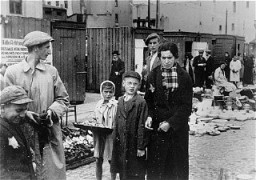
A column of prisoners arrives at the Belzec killing center. Belzec, Poland, ca. 1942. In early 1940 the Germans set up a forced-labor camp for Jewish prisoners in Belzec. The inmates were forced to build fortifications and dig anti-tank ditches along the demarcation line between Germany and Soviet-occupied Poland. The camp was closed down at the end of 1940. The following year, in November 1941, construction began on the Belzec killing center.
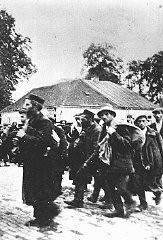
Aerial photograph showing the gas chambers and crematoria 2 and 3 at the Auschwitz-Birkenau (Auschwitz II) killing center. Auschwitz, Poland, August 25, 1944.
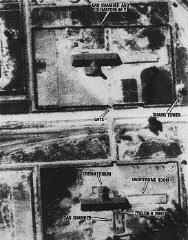
One of many warehouses at Auschwitz in which the Germans stored clothing belonging taken from victims of the camp. This photograph was taken after the liberation of the camp. Auschwitz, Poland, after January 1945.
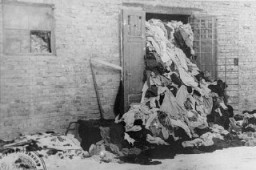
Jews assembled in the Siedlce ghetto during a deportation are forced to march toward the railway station. Siedlce, Poland, August 21–24, 1942.
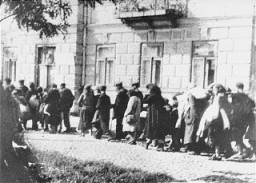
Jews from the Warsaw ghetto are marched through the ghetto during deportation. Warsaw, Poland, 1942–43.

Prisoners at forced labor building an extension to the camp. Auschwitz-Birkenau, Poland, 1942–43.

We would like to thank Crown Family Philanthropies, Abe and Ida Cooper Foundation, the Claims Conference, EVZ, and BMF for supporting the ongoing work to create content and resources for the Holocaust Encyclopedia. View the list of donor acknowledgement.